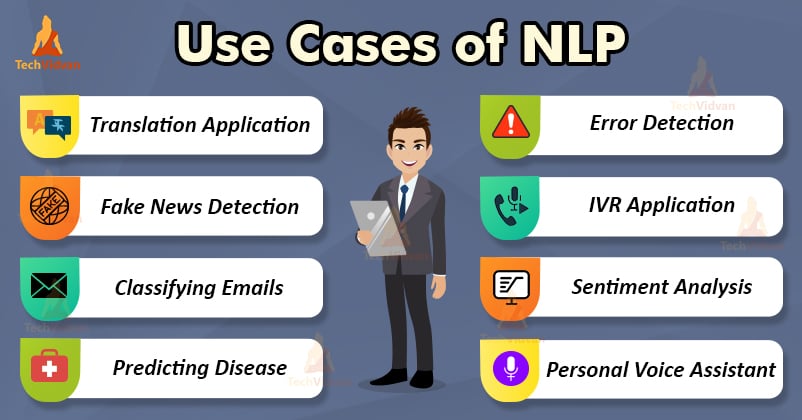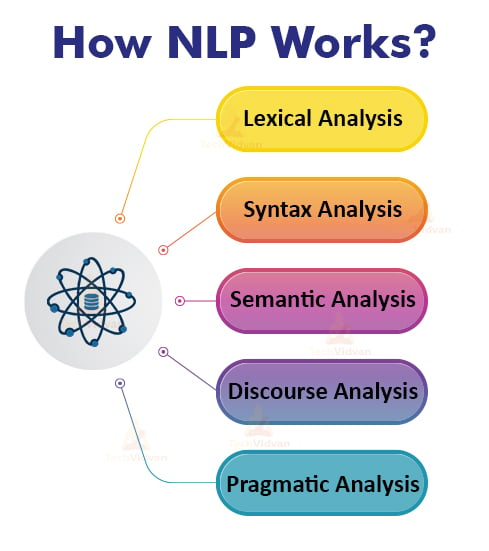What is Natural Language Processing – NLP Use Cases and Working
Have you ever wondered how Siri or Alexa understands what we are saying, do they know our language? If this question ever crossed your mind, then this tutorial is for you. In this TechVidvan Data Science tutorial, you will get answers to all your questions related to this.Actually, this is the power of Natural Language Processing. With the advancements in technology, Natural Language Processing is becoming more popular day-by-day. Let us see some of the aspects related to this advanced technology.
What is Natural Language Processing?
Natural Language Processing or NLP can be considered as a branch of Artificial Intelligence. Through this, we are trying to make the computers capable of reading, understanding, and making sense of human languages. It focuses on teaching the machines how we humans communicate with each other using natural languages such as English, German, etc. Most of the NLP techniques use various supervised and unsupervised machine learning algorithms for extracting valuable insights from the human language. Humans communicate mostly with the help of text and speech. Thus, an NLP system accepts the inputs in the form of speech and text.
NLP Use Cases
Some of the common application areas of NLP are Sentiment Analysis, Named Entity Recognition, Automatic Text Summarization, Automated Question Answering, content categorization, speech to text and text to speech conversion, etc.
Let us see some examples that will make things more clear about the application areas of NLP.
- Translation applications such as Google Translate use NLP for translation.
- NLP helps in detecting fake news. For example, the NLP group at MIT has developed a system that identifies whether a source is politically biased or not. Based on the accuracy it suggests whether to trust a news source or not.
- NLP helps in classifying emails. Companies such as Google and Yahoo analyze the text in our emails for filtering and stopping spams.
- NLP can help to recognize and predict the patient’s medical condition or disease on the basis of his own speech and some other records. For example, Amazon uses a service called Amazon Comprehend Medical. It uses NLP for understanding the patient’s disease status, medications, and treatment results from the patient’s voice notes, clinical trial reports, etc.
- Financial traders use NLP for tracking news, reports, and comments. All the insights gained are then feed in a trading algorithm for generating maximum profits.
- Various word processing applications like Microsoft Word, Grammarly, etc use NLP for checking the grammatical errors in the text.
- Call centers respond to the customers’ requests by using NLP in their Interactive Voice Response(IVR) applications.
- The organizations use NLP to perform sentiment analysis on the customer data collected from social media and other resources. This helps them to get insights about customers’ choices and views about their products.
- Siri, Cortana, Alexa, and other Personal Voice Assistants make use of NLP for responding to our vocal commands.
Terminologies related to Natural Language Processing
1. Phonology: It is a field that studies how sound is organized systematically.
2. Morphology: It is a field that studies how meaningful words are constructed from primitive units.
3. Morpheme: It is the basic unit of meaning in a language.
4. Syntax: Syntax refers to the set of rules which defines how the words can be organized to form sentences and phrases.
5. Semantics: Semantics is a branch that focuses on the meaning of words and sentences. It deals with how to combine words so that it converts into meaningful phrases and sentences.
6. Pragmatics: It is the branch that deals with how the sentences should be interpreted according to different situations.
7. World Knowledge: It refers to the general knowledge about the world.
All these terminologies will help you in understanding the implementation of NLP.
How NLP works?
When we provide a text to the computer as input, it runs various algorithms on it to understand the meaning associated with it. Let us try to understand how NLP does all this.
There are five steps included in NLP which are:
- Lexical Analysis
- Syntax Analysis
- Semantic Analysis
- Discourse Integration
- Pragmatic Analysis
1. Lexical Analysis
In this step, the Lexical Analyzer categorizes the entire input text into words, sentences, and paragraphs. NLP identifies and analyzes the structure of words in the sentences.
2. Syntax Analysis
This process is also called parsing. In this step, the Syntax Analyzer will check the input text for grammatical errors. In this step, the words are arranged in such a way that the relation between them can be identified. Syntactic Analyzer will reject any sentence in the input text which is not correct.
3. Semantic Analysis
In this step, NLP checks whether the text holds a meaning or not. It tries to decipher the accurate meaning of the text. Semantic Analyzer will reject a sentence like “ dry water.”
4. Discourse Integration
The meaning of any sentence is greatly affected by its preceding sentences. Thus in this step, it figures out the meaning of immediately preceding and succeeding sentences.
5. Pragmatic Analysis
In this step, the analyzed text is integrated with the real-world knowledge for extracting the actual meaning of the text.
Techniques used in Natural Language Processing
Syntax Analysis and Semantic Analysis plays a major role in NLP. We have already seen the processes performed in Syntax Analysis and Semantic Analysis. Now we will see an overview of the various techniques used in Syntax Analysis and Semantics Analysis.
1. Syntax Analysis techniques
The several techniques used for Syntax Analysis are:
- Lemmatization: The input may or may not contain the inflected forms of a word. But if it contains inflected forms of some words then it becomes a difficult task for NLP. Thus, through Lemmatization we convert the several infected forms of a word into a single form to make the analysis process easier.
- Morphological segmentation: Morpheme is the basic unit of meaning in any language. Through this technique, we divide the words into morphemes.
- Word Segmentation: Word segmentation is also called word tokenization. In this technique, we divide a large string of natural language into distinct words.
- Part-of-Speech tagging: Through this technique, we identify the part of speech for individual words.
- Parsing: Parsing is the process through which NLP performs grammatical analysis of the sentences.
- Sentence breaking: This technique divides a large piece of text into sentences.
- Stemming: It is also a technique for converting the inflected forms of a word to its root form.
2. Semantic Analysis techniques
The several techniques used for Semantics Analysis are:
- Named Entity Recognition (NER): This technique analyzes and categorizes the input text into predefined groups such as names of the person and names of the places.
- Word Sense Disambiguation: It gives a meaning to the word depending on, in which context it is used.
- Natural Language Generation: It is a translation process. It is a process of converting the computer data into natural language by deriving its semantic intentions.
Importance of Natural Language Processing
The following sentence will clearly define why NLP is so important.
“A computer could be considered intelligent if it could carry out a conversation with a human being without the human realizing they were talking to a machine.”
– Alan Turing
NLP is helping in making the computers more powerful and intelligent. Humans speak a number of languages and each language has its own set of rules. NLP enables us to communicate with computers in our own language and perform a wide range of language-related tasks. Various advanced machine learning and deep learning algorithms help in interpreting the human language. Today a huge amount of unstructured data generates online in the human language. NLP has made it possible for the industries to structure this highly unstructured data collected from discrete sources.
Challenges of NLP
NLP is one of the most difficult problems in Computer Science. Understanding what we humans are saying is a very complex and tedious task for machines. We, humans, are capable of using a number of languages and a wide range of words. It is difficult for computers to understand so many words and other rules for delivering a meaningful message. Whenever we use an abstract form of any language or sarcasm, a number of ambiguities arise in the implementation of NLP by machines. In such situations, it becomes difficult for NLP to decipher the exact meaning of what a person is trying to say.
Future of NLP
At present, the biggest challenge for NLP is the identification of hidden minor details and the true meaning of the natural languages. These hurdles might be because of spelling errors, or the different ways of speaking of different people, etc. There are several examples which indicate that NLP is really struggling in dealing with the meaning associated with languages.
For example, in March 2016, Microsoft performed an NLP experiment. They launched an AI-based chatbot named “Tay” on Twitter. They assumed that the chatbot would learn automatically and get smarter with time by communicating with different types of users. But the results were not so overwhelming. Their experiment failed miserably and Tay started making abusive and racist comments. As a result, they had to remove it within a time-span of 16 hours.
This experience helped Microsoft in making necessary improvements and they again launched another chatbot named “Zo” after some months. Zo was the next generation English-language chatbot of Tay and was a bit smarter.
The companies are also trying to develop bots that can memorize the details of any particular conversations for generating effective conversations.
After all these challenges, NLP is still becoming more and more advanced with time. With this pace of growth, it is possible that many complex applications that were never possible before will become easily implementable in the near future.
Summary
Natural Language Processing plays a very important role in the improvisation of machine-human interactions. In this tutorial, we have explored many aspects related to NLP such as its definition, its uses, how it works, its importance, etc. I hope this tutorial will help you to have a clear understanding of Natural Language Processing.
Hope you liked the article. Do share feedback in the comment section.


